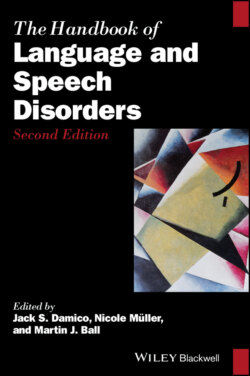Читать книгу The Handbook of Language and Speech Disorders - Группа авторов - Страница 63
4.3.2 Subjective Measures of Intelligibility
ОглавлениеThe second main approach to measurement of speech intelligibility involves subjective measures. Subjective measures of intelligibility generally require listeners to quantify their perception of a speaker’s intelligibility by assigning a number to, or scaling, what they heard (Weismer & Laures, 2002). Direct magnitude estimation (DME) procedures have been used frequently for the study of contributors to intelligibility in dysarthria. DME procedures require listeners to scale the intelligibility of speech relative to a modulus or exemplar. In contrast, use of Likert ratings, or equal appearing interval scales, requires listeners to assign numbers based on perceived similarity to anchor point descriptors (e.g., 1 = very good; 7 = very poor). Although there are a variety of problems with the use of Likert‐type ratings, there is a long history in speech‐language pathology of quantifying subjective phenomena using this approach (i.e., (Darley et al., 1969). One advantage of subjective measures is that a variety of dimensions of speech may be reflected in the numerical rating, and it is possible that intelligibility measures obtained from such a rating may reflect a more holistic view of intelligibility than transcription‐based scores.
Perhaps the most widely referenced screening guidelines and the most widely used clinical tools for speech intelligibility development in children are based on subjective ratings of intelligibility made by parents or other familiar communication partners. For example, Coplan and Gleason (1988) identified cut points for typical intelligibility development in children between 12 months and 5 years of age by asking parents to make a forced‐choice categorical rating regarding how much of their child’s speech they thought a stranger would be able to understand. However, these subjective parent ratings have not been validated with objective measures of intelligibility, thus the extent to which parents rate their child accurately relative to some objective standard is unknown.
More recently, McLeod and colleagues (McLeod, Crowe, & Shahaeian, 2015; McLeod, Harrison, & McCormack, 2012) developed the Intelligibility in Context Scale (ICS) to characterize intelligibility of children across different communication partners and contexts, as revealed by parent ratings. The ICS asks parents to rate their perception of their child’s intelligibility on a 5‐point scale across seven different contexts. Studies of the ICS have examined its relationship with segmental measures such as percentage consonants correct, percentage vowels correct, and percentage phonemes correct, as scored on standardized tests. The ICS has not been examined relative to other measures of intelligibility to our knowledge. It is widely used and has been translated into more than 60 languages (McLeod et al., 2015), however, normative data are limited and growth curves have not been developed.
In a recent study, Natzke and colleagues (Natzke, Sakash, Mahr, & Hustad, 2020) examined measures of intelligibility including percentage of intelligible utterances, parent ratings of intelligibility, and multiword transcription intelligibility scores from elicited utterance, all obtained from the same children at three longitudinal time‐points. Their results found weak associations between measures, suggesting that different measures of intelligibility are not reflective of one another even for the same children. Results also showed that not all measures were sensitive to growth over time. Large‐scale studies of intelligibility using consistent methods across the full range of development are currently underway.
